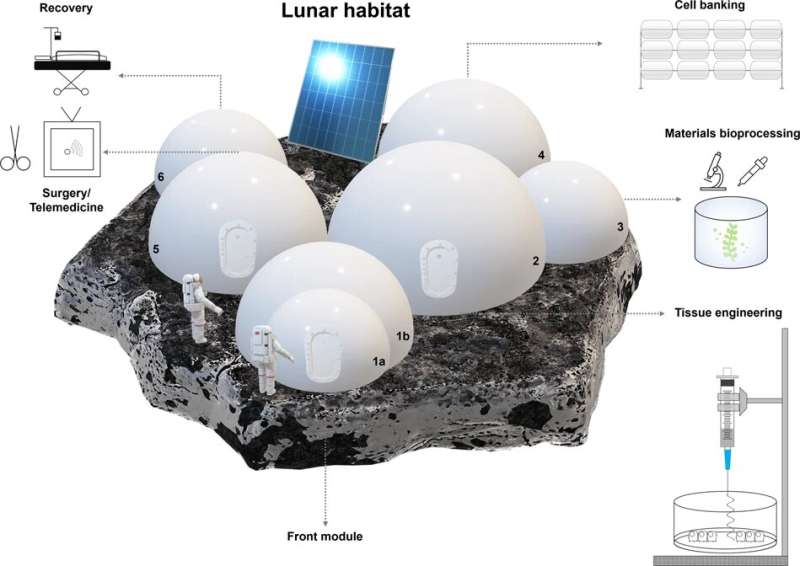Tunnels deep underground in North Yorkshire are providing a unique opportunity to study how humans might be able to live and operate on the moon or on Mars.
Researchers at the University of Birmingham have launched the Bio-SPHERE project in a unique research facility located 1.1 km below the surface, in one of the deepest mine sites in the UK. The project investigates how scientific and medical operations would take place in the challenging environments of the moon and Mars.
It is the first of a series of new laboratory facilities planned to study how humans might work—and stay healthy—during long space missions, a key requirement for ensuring mission continuity on other planets.
The team is working in partnership with the Boulby Underground Laboratory, a 4,000m3 deep underground facility focused on particle physics, Earth sciences and astrobiology research, run by the Science and Technology Facilities Council (part of UK Research and Innovation) with the support of the Boulby Mine operators, ICL-UK.
The Bio-SPHERE project is based in a 3,000m3 tunnel network adjacent to the Boulby Laboratory, which go through 250-million-year-old rock salt deposits, consisting of Permian evaporite layers left over from the Zechstein Sea. This geological environment, together with the deep subsurface location, have enabled researchers to recreate the operational conditions humans would experience working in similar caverns on the moon and Mars. This includes remoteness, limited access to new materials and challenges in moving heavy equipment around.
At the same time, thanks to the ultra-low radiation environment provided by that depth, the location will enable scientists to investigate how effective underground habitats might be in protecting space crews from deep-space radiation, which is a significant risk in space exploration, as well as other hazards, such as falling debris from meteorites, which risks damaging the life-support infrastructure.
The first facility to be opened as part of Bio-SPHERE (Biomedical Sub-surface Pod for Habitability and Extreme-environments Research in Expeditions), is based in a 3-meter-wide simulation module and is designed specifically to test biomedical procedures needed to prepare materials for treating tissue damage. These include complex fluids, polymers and hydrogels for regenerative medicine that could be used, for example, in wound dressings, or fillers for damage mitigation.
A paper describing the concept and design of such a habitat was recently published in npj Microgravity.
Bio-SPHERE, which includes a range of capabilities for sterile work and material processing, combines these simulation facilities and useful geological environment with access to the adjacent physics and chemistry laboratory facilities.
This environment provides the opportunity to simulate various mission scenarios and to conduct cutting edge, interdisciplinary science, ranging from the effects of extreme environments on biological and physicochemical parameters and on medical infrastructure, all the way to investigating how available 'in-situ' resources such as ambient pressure, temperature and geology can be used for habitat construction.
Lead researcher Dr. Alexandra Iordachescu, in the University of Birmingham's School of Chemical Engineering, said, "We are excited to be partnering with the fantastic science team at the Boulby Underground Laboratory. This new capability will help to gather information that can advise on the life support systems, devices and biomaterials which could be used in medical emergencies and tissue repair following damage in deep-space missions."
"These types of metrics can guide system design and help to assess the scientific needs and acceptable timeframes in bioengineering operations under the constraints of isolated environments, such as space habitats. The data is likely to bring numerous benefits for Earth-based applications as well, such as delivering biomedical interventions in remote areas or in hazardous environments and more generally, understanding biomedical workflows in these non-ideal environments."
Professor Sean Paling, Director and Senior Scientist at the Boulby Underground laboratory said, "We are very pleased to be working with Dr. Iordachescu and the team from the University of Birmingham on this exciting work. The challenges ahead for humankind in exploring habitats beyond Earth are clearly many and significant."
"The Bio-SPHERE project promises to help answer some key logistical questions in establishing sustainable living conditions in remote, subterranean environments and in doing so will significantly contribute to the essential preparations for our collective long, difficult and exciting journey ahead. It is also a great example of the diverse range of science studies that can be carried out in a deep underground science facility, and we are very happy to be hosting it."
More information: Alexandra Iordachescu et al, Space habitats for bioengineering and surgical repair: addressing the requirement for reconstructive and research tissues during deep-space missions, npj Microgravity (2023). DOI: 10.1038/s41526-023-00266-3
Provided by University of Birmingham



